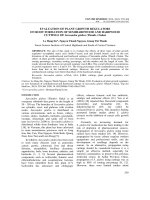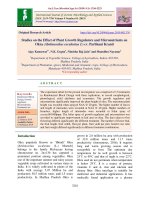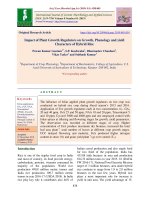Effect of plant growth regulators on flowering parameters of Ber (Zizyphus mauritiana Lamk)
Bạn đang xem bản rút gọn của tài liệu. Xem và tải ngay bản đầy đủ của tài liệu tại đây (305.31 KB, 7 trang )
Int.J.Curr.Microbiol.App.Sci (2020) 9(3): 2684-2690
International Journal of Current Microbiology and Applied Sciences
ISSN: 2319-7706 Volume 9 Number 3 (2020)
Journal homepage:
Original Research Article
/>
Effect of Plant Growth Regulators on Flowering Parameters
of Ber (Zizyphus mauritiana Lamk)
Kishore Kumar Das*, P. K. Yadav, S. R. Bhunia and R. S. Singh
Swami Keshwan and Rajasthan Agricultural University, Bikaner, Rajasthan, India
*Corresponding author
ABSTRACT
Keywords
NAA, GA, BAP,
fruit retention,
fruit drop
Article Info
Accepted:
20 February 2020
Available Online:
10 March 2020
The study was conducted at Niche Area of Excellence Farm, SKRAU,
Bikaner (Rajasthan), during the year 2017-18 and 2018-19. Foliar
application of plant growth regulators viz. NAA (0, 20 & 40 ppm), GA3 (0,
20 & 40 ppm), BAP (0, 10, 20 ppm) were applied 6 years old ber trees. The
results revealed that treatment NAA 20 ppm significantly minimize the
days taken for initiation of flowering, days taken for 50% blooming and
days taken for full bloom, and harvesting. NAA 20 ppm increased fruit set,
fruit retention, least fruit drop, in both the years as well as in polled
analysis as compare to control. Similarly, application of GA3 20 ppm
increased fruit set, fruit retention and least fruit drop, during both the years
and pooled mean as compared to control.
Introduction
Ber (Zizyphus mauritiana Lamk), the poor
man’s fruit is one of the most ancient and
common indigenous fruit in India and
belonging to family Rhamnaceae. According
to De Candolle (1886), the centre of origin for
this fruit crop is central Asia and it is found
growing wild as well as in cultivated forms
throughout the warmer regions up to an
altitude of 1500 meters above mean sea level.
It can be successfully grown even in the most
marginal ecosystems of the sub-tropics and
tropics (Pareek, 2001). Ber is popular due to
its high economic returns, low cost of
cultivation wider adaptability and ability to
withstand drought (Gupta, 1983). The Indian
jujube is native of Province of Yunnan in
southern China to Afghanistan, Malaysia and
Queensland, Australia. Ber has been in use for
almost 4000 years in India.
It is cultivated to some extent throughout its
natural range but mostly in India where it is
grown commercially and has received much
horticultural attention and refinement despite
the fact that it frequently escapes pests.
Specimens are scattered about the drier parts
2684
Int.J.Curr.Microbiol.App.Sci (2020) 9(3): 2684-2690
of the West Indies, the Bahamas, Colombia,
Venezuela, Guatemala, Belize, and southern
Florida. In Barbados, Jamaica and Puerto
Rico the tree is naturalized and forms thickets
in uncultivated areas. Zizyphus sp. found
growing wild, semi wild and also cultivated in
almost all parts of India. The major growing
states are Madhya Pradesh, Bihar, Uttar
Pradesh, Punjab, Haryana, Rajasthan, Gujarat,
Maharashtra and Andhra Pradesh. Ber
occupied an area of 858 thousand hectare with
an annual production of 481 thousand MT per
year in India (NHB, 2017).
Plant growth regulators play a significant role
in many physiological phenomena. Those are
being used in vegetative propagation,
regulation of flowering, thinning of flower
and fruit, artificial induction of seedlessness,
improvement of fruit set and size and
prevention of pre-harvest fruit drop. Plant
growth regulators also play major role in the
development of fruits (Singh et al., 1990).
They act as metabolic sink for the diversion
of metabolic from one part to other of the
plant specially towards developing fruits. The
pre harvest sprays of PGRs being used to
control fruit drop and to improve fruit
retention percentage. Among various plant
growth regulators, NAA is an important
growth regulator of auxin group, which helps
to reduce fruit drop and to improve fruit set
and quality specially TSS.
Gibberellic acid is an important growth
regulator of gibberellins group and used to
improve fruit size and quality viz. to increase
the juice percentage and TSS. GA3 also found
use in increasing sugar content, inducing
flowering, delaying in maturity and producing
seedlessness. The effects of synthetic
cytokinins are consistent with the functions of
the endogenous compounds. Following
application,
enhanced
chloroplast
differentiation and chlorophyll synthesis
result in delayed senescence. Cytokinins have
been implicated in apical dominance. The
synthetic cytokinins usually stimulate flower
induction.
Materials and Methods
The study entitled “Effect of Foliar Spray of
Plant Growth Regulators on Flowering, Fruit
drop, Yield and Quality of Ber (Zizyphus
mauritiana Lamk) in Arid Conditions” was
conducted at Niche Area of Excellence Farm,
SKRAU, Bikaner (Rajasthan), during the year
2017-18 and 2018-19.The experiment was
laid out in Randomized Block Design having
27 treatments with three replications each.
Foliar application of plant growth regulators
viz. NAA (0, 20 & 40 ppm), GA3 (0, 20 & 40
ppm), BAP (0, 10, 20 ppm) were applied 6
years old ber trees. The plants cv. Gola
selected for study and a uniform cultural
schedule was followed in all the treatments
during the course of investigation.
Results and Discussion
The perusal of data in table 4.1 revealed that
application of NAA resulted into a significant
difference between the treatments in both
years (2017-18, 2018-19 and pooled mean).
The minimum days taken for initiation of
flowering (6.41 days), days taken to 50%
blooming and full blooming was found in the
plants receiving treatment NAA 40 ppm
which was at par with treatment NAA 20
ppm, while delayed initiation of flowering,
days taken to 50% blooming and full
blooming was observed in control (NAA 0
ppm) in both year and pooled mean.
Flowering of ber was associated with reduced
vegetative growth and available evidence
strongly suggest that flower initiation depends
on the presence of an unknown flower
promoting factor or factors synthesised in the
leaves. As NAA was found to have flowering
2685
Int.J.Curr.Microbiol.App.Sci (2020) 9(3): 2684-2690
promoting activity (Oksher et al., 1980). The
observed reduction in vegetative growth in
present investigation may be due to inhibitory
effect of flower promoting factors on
vegetative growth in plants; because of NAA
is a flowering hormone. Flower bud initiation
and flowering are guided by different plant
hormones and the nutrient status of the plant.
Early flowering would refer to an early
morphological differentiation. Flowering is
mediated by increased levels of endogenous
auxinthat may simply hasten flower
emergence of a differentiated dormant bud.
The earliness in blooming of flower bud due
to NAA treatment might be associated with its
action in promoting the flow of metabolites
towards flowering buds and thus fasten the
floral development (Krishna et al., 2017).
Similar results were observed by Lal et al.,
(2013) in guava. It is evident from the table
(4.2) that fruit set and fruit retention was
significantly influenced by spray of NAA.
Foliar spray of NAA at 40 ppm significantly
increased the fruit set (92.31, 91.31, and
91.81 percent) and retention (61.13, 59.43,
60.28) of ber over control in both the years
(2017-18 and 2018-19) and pooled basis
respectively. However, NAA 40 ppm and
NAA 20 ppm levels were at par in respect of
fruit set and fruit retention. However, NAA
40 ppm and NAA 20 ppm increased fruit set
by (8.33, 10.06, 9.18 percent and 6.9, 9.25,
8.06 percent) and fruit retention (20.98, 24.63
and 22.75 percent and 20.45, 23.01 and
21.70) as compared to control, respectively.
Data (Table 4.2 further revealed that
application of GA3 significantly increased the
fruit set and fruit retention percentage of ber
over control during the year 2017-18, 2018-19
and pooled mean. Among the levels of GA3
40 ppm recorded maximum fruit set (92.64,
91.72, and 92.18 per cent) and fruit retention
(61.06, 59.91, and 60.48) followed by GA3 20
ppm. The least fruit set and fruit retention
percentage were observed in control (GA3 0
ppm). The effect of Treatment NAA
accelerates the metabolic activities of the
plant by increasing the meristematic activities
which in turn increases the vegetative growth,
more photosynthesis and ultimately lead to
increase flowering, maximum fruit setting and
maximum fruit retention per cent. Similar
results have also been reported by Zang and
Lei (2000) and Shankar et al., (2002) in
guava.
The dropping of fruit might be due to low
auxin activity or limited auxin like precursor
for developing fruits as reported in navel
orange (Lima and Davies, 1984). Reduction
in fruit drop in this experiment by the
application of growth regulators may be
attributed by correcting the deficiency of
endogenous auxin which prevents the
formation of abscission layer possibly through
the inhibition of enzymatic activity such as
pectinase,
cellulose
and
also
polygalactauronase (Singh and Singh, 1976)
in ber.
The higher fruit set in response to higher
concentration of growth substances like GA₃
application is probably due to translocation of
hormones, food substances and other factors
stimulating fruit formation to the tissue of
ovary in greater amount. It is clear from the
data (Table 4.2) that application of NAA
brought about significant variation in fruit
drop of ber during both the years (2017-18
and 2018-19) and pooled mean.
The least fruit drop percentage was observed
in NAA 40 ppm (31.26, 31.86, and 31.55)
followed by NAA 20 ppm (31.91, 32.13,
32.02). The maximum fruit drop was
observed in NAA 0 ppm. Further revealed
that application of GA3 40 ppm was recorded
minimum fruit drop (32.07, 32.10, 32.09
percentage) which was at par with GA3 20
ppm (32.28, 32.59, 32.43 percentage) during
both years and pooled basis.
2686
Int.J.Curr.Microbiol.App.Sci (2020) 9(3): 2684-2690
Table.1 Effect of foliar application of NAA, GA3 and BAP on flowering of ber
Treatments
Initiation of flowering
2017-18
2018-19
Levels of NAA (ppm)
8.33
6.93
NAA0
Pooled
Days taken for 50% blooming
2017-18
2018-19
Pooled
Days taken for full bloom
2017-18
2018-19
Pooled
7.63
16.81
16.93
16.87
36.85
35.67
36.26
NAA20
6.50
5.36
5.93
15.59
15.67
15.63
35.37
33.61
34.49
NAA40
6.41
5.17
5.79
15.26
15.40
15.33
35.07
33.26
34.17
SEm±
0.141
0.137
0.098
0.158
0.209
0.131
0.294
0.287
0.205
C.D. (P=0.05)
0.399
0.390
0.276
0.450
0.594
0.368
0.833
0.813
0.575
Levels of GA3 (ppm)
7.01
GA0
7.14
GA20
5.99
5.88
6.50
6.51
16.11
15.89
15.97
16.27
16.04
16.08
35.74
35.93
34.12
33.86
34.93
34.89
GA40
7.10
5.58
6.34
15.67
15.75
15.71
35.63
34.56
35.10
SEm±
0.141
0.137
0.098
0.158
0.209
0.131
0.294
0.287
0.205
C.D. (P=0.05)
N.S
N.S
N.S
N.S
N.S
N.S
N.S
N.S
N.S
Levels of BAP (ppm)
7.19
BAP0
5.69
6.44
15.85
16.08
15.97
35.85
34.60
35.23
BAP10
7.05
5.99
6.52
16.04
15.93
15.99
36.07
34.08
35.08
BAP20
7.01
5.77
6.39
15.78
15.97
15.87
35.37
33.86
34.61
SEm±
0.141
0.137
0.098
0.158
0.209
0.131
0.294
0.287
0.205
C.D. (P=0.05)
N.S
N.S
N.S
N.S
N.S
N.S
N.S
N.S
N.S
N.S- Non Significant
2687
Int.J.Curr.Microbiol.App.Sci (2020) 9(3): 2684-2690
Table.2 Effect of foliar application of NAA, GA3 and BAP on fruit set, fruit drop and fruit retention of ber
Treatments
Fruit set (%)
2017-18
2018-19
Levels of NAA (ppm)
Pooled
Fruit drop (%)
2017-18
2018-19
Pooled
Fruit retention (%)
2017-18
2018-19
Pooled
NAA0
85.21
82.96
84.09
34.55
34.74
34.64
50.75
48.31
49.53
NAA20
91.10
90.64
90.87
31.91
32.13
32.02
61.13
59.43
60.28
NAA40
92.31
91.31
91.81
31.26
31.86
31.56
61.40
60.21
60.80
SEm±
0.282
0.546
0.307
0.292
0.309
0.213
0.417
0.261
0.417
C.D. P=0.05)
0.800
1.549
0.862
0.830
0.877
0.596
1.184
0.732
1.184
Levels of GA3 (ppm)
83.85
GA0
92.15
GA20
81.58
91.62
82.71
91.88
33.36
32.28
34.03
32.59
33.69
32.43
51.39
60.82
48.58
59.47
49.98
60.15
92.64
91.72
92.18
32.07
32.10
32.09
61.06
59.91
60.48
SEm±
0.282
0.546
0.307
0.292
0.309
0.213
0.314
0.417
0.261
C.D. P=0.05)
0.800
1.549
0.862
0.830
0.877
0.596
0.892
1.184
0.732
GA40
Levels of BAP (ppm)
BAP0
89.44
87.92
88.68
33.22
33.57
33.40
56.13
54.65
55.39
BAP10
89.56
88.27
88.92
32.28
32.89
32.59
58.43
56.61
57.52
BAP20
89.63
88.73
89.18
32.21
32.26
32.23
58.71
56.68
57.70
SEm±
0.282
0.546
0.307
0.292
0.309
0.213
0.314
0.417
0.261
C.D. P=0.05)
N.S
N.S
N.S
0.830
0.877
0.596
0.892
1.184
0.732
N.S- Non Significant
2688
Int.J.Curr.Microbiol.App.Sci (2020) 9(3): 2684-2690
The maximum fruit drop was observed in
control (33.36, 34.03, and 33.69 percent). The
percent fruit drop was reduced by the
application of GA3 40 and 20 ppm and it was
3.86, 5.67, 4.74 and 3.23, 4.23, 3.73 percent
as compared to control, respectively.
Application of BAP also significantly
minimizes the fruit drop percentage of ber.
endogenous hormone at appropriate level,
potent to enough reduce the fruit drop.
It is concluded that application of NAA 20
ppm, GA 20 ppm and BAP 10 ppm increases
fruit set and fruit retention and reduce fruit
drop as compared to rest of treatments.
References
The treatment BAP 20 ppm was recorded
minimum fruit drop percentage (32.21, 32.26,
32.23) and maximum fruit drop percentage
was recorded in control BAP 0 ppm (33.22,
33.57, 33.40). It also showed that BAP 20
ppm was statistically at par with the treatment
BAP 10 ppm (32.28, 32.89, and 32.59).
However, BAP 20 ppm and 10 ppm reduced
fruit drop by 3.04, 3.90, 3.50 percent and
2.82, 2.02, 2.41 percent as compared to
control, respectively.
The dropping of fruit might be due to low
auxin activity or limited auxin like precursor
for developing fruits as reported in navel
orange (Lima and Davies, 1984). Reduction
in fruit drop in this experiment by the
application of growth regulators may be
attributed by correcting the deficiency of
endogenous auxin which prevents the
formation of abscission layer possibly through
the inhibition of enzymatic activity such as
pectinase,
cellulose
and
also
polygalactauronase (Singh and Singh, 1976)
in ber.
The primitive effect of growth substances in
greater retention of fruit may be attributed to
reduction in fruit drop. There is correlation
between fruit drop and endogenous hormonal
status, and existence of high level of internal
auxin that prevent fruit drop. This action of
GA3 might have raised auxin level leading to
diminished drop rate and attributed to its
reduction in fruit drop which prevents the
formation of abscission layer as reported by
Addicot (1970) in apple. Since high level of
Addicot, F.T. 1970. Plant harmone in control
of abscission. Biol. Rev., 45: 485-524.
Gupta, A.K., H.S. Panwar, and B.B.
Vashishtha. 1983. Studies on physicochemical changes in ber (Ziziphus
mauritiana Lamk). Indian J. Hortic.,
41:52-57
Krishna, G. V., Bhagwan, A. M., Kumar, R.
and Shankar, A. S. 2017. Effect of
flower
enhancing
plant
growth
regulators and fruit set improving
chemicals on vegetative growth, early
flower initiation and fruit yield of
mango (Mangifera indica L.) cv.
Banganpalli. Int. J. Pure App. Biosci., 5
(3): 667-677
Lal, N., Das, R.P. And Verma, L. R. 2013.
Effect of plant growth regulators on
flowering and fruit growth of guava
(Psidium guajava L.) cv. Allahabad
Safeda. The Asian Journal of
Horticulture., 8(1): 54-56.
Lima, J.E.O. and Davies, F.S. 1984. Growth
regulators, fruit drop, yield and quality
of Navel orange in Florida. J. Amer.
Soc. Hort. Sci., 109(1): 81-84.
NHB, 2017. Ministery of Agriculture and
Farmers Welfaire, Government of India.
Oksher, A.K., Ramachandran, C. and
Pyhodath, J.S. 1980. Effect of planofix
on fruit set in mango. Agric. Res. J.
Kereale, 17(1): 105
Pareek, O.P. 1983. The Ber: Indian Council of
Agricultural Research, New Delhi.
Pareek, O.P. 2001. Ber: International Centre
2689
Int.J.Curr.Microbiol.App.Sci (2020) 9(3): 2684-2690
for Underutilized crops,
Shankar, U., Pathak, R.A., Pathak, R.K. and
Ojha, C.M. 2002. Effects of NPK on the
yield and fruit quality of guava cv.
Sardar. Prog. Hort., 34 (1): 49-55.
Singh, U.R., and Singh, N. 1976. Effect of
plant growth regulators on fruit drop,
size and quality of ber (Z. mauritiana
Lamk) cv. Banarsi. Haryana J. Hort., 5
(1- 2): 1-8.
Zang, X. P. and Lei,X. T. 2000. The
application of fertilizer for guava trees.
South China Fruits., 29(6): 29-31.
How to cite this article:
Kishore Kumar Das, P. K. Yadav, S. R. Bhunia and Singh. R. S. 2020. Effect of Plant Growth
Regulators on Flowering Parameters of Ber (Zizyphus Mauritiana Lamk).
Int.J.Curr.Microbiol.App.Sci. 9(03): 2684-2690. doi: />
2690
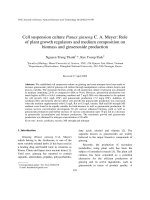
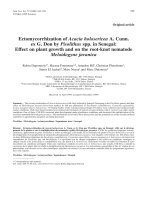


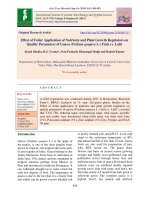
![Effect of different plant growth regulators on shooting of stem cuttings in dragon fruit [Hylocereus undatus (Haworth) Britton & Rose]](https://media.store123doc.com/images/document/2020_01/09/medium_isb1578564896.jpg)
